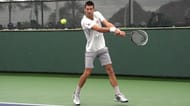Coming in a close second to Andre Agassi, Novak Djokovic has the best service returns in the modern game. Despite having an extreme forehand grip, the Serbian has a very short and compact back-swing where his arms do very little to bring the racket into position for the forward swing.
In the ready position (waiting for the ball to be served), Djokovic appears to wait with his right hand in a relatively neutral grip in between his forehand grip and his backhand grip. His left hand is generally always positioned in his backhand grip.
He moves his right hand into his forehand grip which results in him having an extreme forehand grip with his right hand, despite not knowing where the ball is going to come from. If he realises that the ball is coming to the backhand side, he turns his upper body and at the same time changes his right hand into his backhand grip.
The extreme forehand grip problem
Many players including Novak, hit forehands with an extreme grip. The challenge with an extreme forehand grip on the return of serve is that it takes longer to get from the forehand grip to the backhand grip when players make their grip change. Players must also be quick to adjust from the end of the back-swing to contact to get the racket face vertical or straight up and down.
How does Djokovic combat this?
Before returning serves on his backhand, Djokovic is quick to get into position where the racket does not go behind his back, he turns his upper body so that the back-swing is short and compact. Novak’s racket face and arms are positioned to not have to make any unnecessary adjustments till the time he makes contact. At contact, it is crucial that Djokovic’s racket face stays vertical. As the Serbian gets into position, he makes sure that the strings of his racket points sideways and therefore when he moves the racket forward to contact the ball, the racket face will automatically be vertical.
The problem that players in general have is that in the key position at the end of the back-swing, the strings of their racket point upwards or downwards which leads them to adjust from there to contact, costing them time and throwing back framed returns.

The minimal adjustment
Like the backhand side, as Djokovic recognises the forehand return, he turns his upper body and the back-swing is short and compact. However, in a major difference to his backhand return, the strings of Djokovic’s racket point slightly downwards while returning from the forehand side. This is a result of his extreme forehand grip. Again, it becomes crucial from this position he finds himself in, to make minimal adjustment to get the strings of his racket vertical.
Notably, Djokovic also has a wide split step when he tries to pivot onto the ball of his hitting foot, and the wider the split step, the wider serves he can reach without stepping. He times his split step precisely, so the balls of his feet contact the court at the instant the serve is hit by his opponent.
Djokovic manages to still return extremely well on the forehand side because of how coordinative he is. This allows him to adjust the racket face vertical in the last millisecond before contact, and he gets it right almost every single time.
This minimal alteration before contact is what makes it so much more difficult to return well with an extreme forehand grip and that is also the reason why most players with a grip like this stand way behind the baseline when they return. On the other hand, Novak manages to stay in close to the baseline manages to return incredibly well also on the forehand side.
How did Novak Djokovic meet Jelena Ristic? All about the most admired couples in tennis
